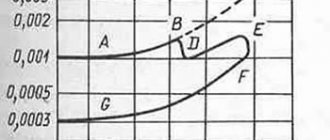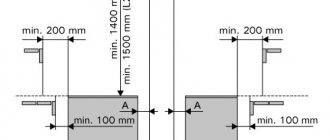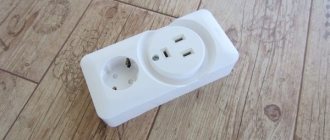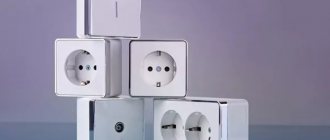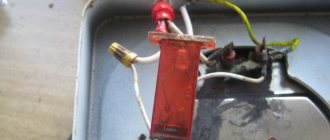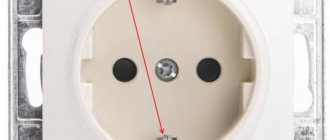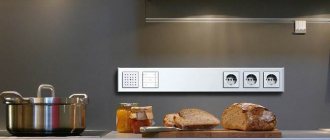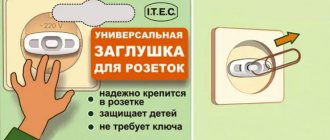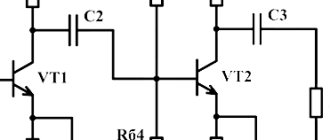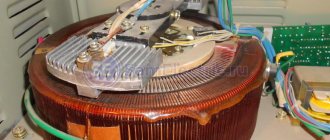Published: November 25, 2012 Category: Electrical Views: 12515
The main task of the socket is to create reliable electrical contact with the power plug of the device after switching on, while the socket must be completely safe for humans
Electricity is used literally everywhere. That is why reliable devices that provide access to it are so necessary. In everyday life, electrical outlets are used to access the power grid. They can work properly for many years, but sometimes they become unusable.
Electrical sockets are used to connect electrical appliances and electrical machines to the electrical network. The main task of the socket is to create reliable electrical contact with the power plug of the device after switching on. In addition, sockets must be completely safe for humans, and their design must completely prevent unintentional contact with wires and parts that are or may be live.
Currently, the requirements for the safety and appearance of sockets have increased significantly. Specific application conditions dictate the color and shape of the parts protruding above the wall; increasingly, sockets must be assembled into a module (it may include connectors for a telephone line, television cable and computer network).
What types of socket terminals are there?
According to the method of fastening, sockets are divided into products with screwless (automatic) and screw terminals. Let's consider these options in more detail.
Screw terminals
The wire is clamped with a screw, located between two contact plates. As a result, when a load occurs, it heats up, and when it disappears, it naturally cools down. In this case, the metal, as is known, expands when heated. Therefore, this process, and then the narrowing of the wire, constantly “swings” the terminal. After a certain time, the contact between the terminal and the wire deteriorates, and carbon deposits appear, which subsequently leads to breakdown of the socket. For screw terminals, it is best to use aluminum wires. While functioning, they begin to deform over time (professionals call this process “estrus”). And then the weakened contact sparks and heats up. But to solve this problem, you just need to “tighten” the screw in time, and the socket can function again without problems for some time.
But you also need to remember if low-quality products are used, or the installation was not carried out professionally, and also when using a large number of devices through tees with one socket (or when working with several extension cords), a fire may occur. It is for this reason that since 1967 the use of screw terminals has been prohibited by law in Germany. In the Russian Federation, such products are quite widely used, but with a clear recommendation that all screw terminals must be tightened at least once every 6 months, to which many users, of course, do not respond.
Automatic terminals
They have a specialized tooth that is bent inside the product. The wire is pressed against it by another spring. Installation using this screwless clamp is quite simple. First, the wire is stripped to the required length and inserted into the terminal. It is clamped automatically. To remove this wire back, you just need to press the button - and it will go out without any resistance. In this case, it is impossible to pull out the wire without pressing this lever. Of course, automatic terminals are a little more expensive than their screw counterparts, but they are easy to maintain and do not require periodic (every six months) tightening of the wiring. In addition, reliable contact between the terminal and the wire is guaranteed. Typically, copper wire options are used for these types of clamps.
Arrangement of electrical sockets
When designing sockets, the so-called modular method is used. In this case, the device mechanism is designed as a separate unit (functional module), which can be installed in any standard devices. At the same time, the decorative module (overlay) can be changed according to fashion, tastes or the interior of the room. In this case, the mechanism itself does not require replacement. This is all the more convenient since it is the mechanism that is attached to the load-bearing surface (for example, to the wall).
Multi-module electrical socket
The base of the functional module and the decorative parts of the sockets are made of special plastics. They are good dielectrics, have high strength at normal and elevated temperatures, do not support combustion, do not change color and are not destroyed under the influence of electromagnetic fields and ultraviolet light. In the European Union countries, for example, high-strength ABS plastic and polycarbonate are used for this purpose. But porcelain is prohibited in these countries for the production of sockets and other similar devices, as it is not the most reliable of dielectrics.
So, any electrical appliance that has a connecting cord with a power plug can be connected to a source of electricity. Simply insert this plug into an electrical outlet of the appropriate design. However, such a connection can be considered correct only if, when electric current flows, the contacts formed by the plug and socket do not heat up or spark. This can be ensured if the socket electrodes are in reliable contact with the plug pins and fit them tightly, providing a large contact area. Each such electrode is made in the form of a spring-loaded receiving socket. Its original diameter is slightly smaller than the diameter of the plug pin, so when plugging it into a socket we must apply some force to overcome the elasticity of these sockets.
The design of the socket outlets and the material from which they are made must ensure a sufficiently large number of repetitions of the “on-off” cycle without deteriorating the quality of the contacts. Sockets from the company, which are considered leaders in their industry, allow for at least 5000 such cycles, which is equivalent to a service life of 6-10 years (provided that the socket is used 1-2 times a day).
The socket's receiving sockets are connected to its terminals, to which the electrical wiring wires are connected. Moreover, in modern devices this connection is not made as a separate part, but as a branch of a monolithic plate from which the receiving socket is made. In this way, it is possible to avoid additional connections that are undesirable from a reliability point of view in the path of the electrical current.
Of great importance for the reliability of the socket is the quality of the mechanical connection of the supply wires to its terminals and the reliability of the electrical contact in this connection. In other words, the terminals must firmly hold the wires and ensure reliable contact with the live parts of the socket. The most famous and, perhaps, still the most reliable for power wiring and sockets are screw terminals. In them, the wires are pressed against live parts using screws. Their main advantage is that the force with which the wires are clamped into the terminal can be quite significant, and this ensures both good wire retention and reliable electrical contact. However, in order to prevent the clamp from loosening due to vibration or heating, it is advisable to use screws in the terminals together with spring washers, which prevent spontaneous unscrewing of the fasteners.
Socket clamp terminals
Spring terminals are often used in the design of household electrical outlets. Their advantage is that they greatly facilitate the connection of wires. To do this, simply insert the bare end of the wire with some force into a special hole on the socket body. A spring-loaded “knife” inside the terminal will fix the wire and press it against the live parts of the socket. But the strength of such a “clamp” is difficult to control, and if for some reason it becomes loose, the unreliable contact of the wire with the socket will go unnoticed at the installation stage and will lead to premature failure of the socket.
The conditions for installing sockets quite often force you to connect not one, but two wires to each terminal. Taking this into account, both screw and spring terminals have two seats or holes for wires. But when connecting wires in pairs, it is necessary to ensure that their diameters are either the same or differ very slightly. Otherwise, a wire with a smaller diameter will be poorly fixed. For example, it is almost impossible to securely clamp a wire with a cross-section of 1.5 mm² with one screw if a wire with a cross-section of 2.5 mm² is connected at the same time.
As you know, to connect household electrical appliances you need two single-core wires or one double-core. Therefore, each socket has at least two insulated terminals and receiving sockets, and if the electrical wiring is made with a three-core wire, in which the third conductor is grounding, then on such electrical wiring it is advisable to install sockets with additional grounding electrodes (the so-called “sockets with grounding”). According to safety requirements, these electrodes are located in the socket structure so that when a plug that has similar electrodes is turned on, the grounding electrodes on the plug and socket come into contact before the pins of the plug come into contact with the receiving sockets of the socket. Therefore, the grounding electrodes are always clearly visible on the socket. These are either two metal plates on the sides, or one metal pin, very similar to the pin of a power plug. The grounding electrodes are connected to their terminal, to which the grounding wire of the electrical wiring is connected.
Grounding socket and plug
The most important technical characteristics of electrical outlets are the permissible electric current and operating voltage. As a rule, in the internal electrical wiring of residential and office premises, sockets are used that are designed for a current of 10 or 16 A and an operating voltage of up to 250 V. So that the current-carrying parts of the sockets are able to pass such a current with minimal heat generation (in other words, without heating), for them production uses special metal alloys with a relatively high copper content (10-60%). The electrical conductivity of such alloys is quite high and allows this condition to be met without a significant increase in the size of current-carrying parts and the sockets themselves. At the same time, these alloys are harder than pure copper and have the elasticity necessary for the correct functioning of the socket sockets.
Terminal box
Obviously, the above-mentioned permissible currents for sockets correspond to the range of electrical power consumption values in which the vast majority of electrical household appliances operate. And only kitchen electric stoves will require special, more powerful sockets (connectors). But even more often they are connected without sockets at all - through terminal boxes.
Sockets for kitchen electric stoves
What are the advantages of automatic terminals?
Screwless clamp technology is an effective, instant and safe method of making an electrical connection in a socket, which even a non-professional can successfully handle. This method significantly reduces the time required for connection and eliminates the need for preventative maintenance, while ensuring high-quality contact.
Simple and effective installation There is no need to tighten the screws when connecting. Installation is carried out instantly, as already mentioned, with one click of a button. This eliminates problems typical of screw mechanisms due to excessive or, conversely, insufficient tightening. In addition, there is no need to constantly tighten a loose connection. When the wire is fixed with a clamp as a result of installation, the contact becomes securely fastened.
Resistance to a variety of influences The risk of breaking or weakening of the connection due to shock or vibration completely disappears.
Types of sockets
Devices that have reached the end of their service life require replacement with new ones. This is necessary to avoid some dangerous moments - short circuits and electric shock to residents. Before installing an electrical outlet, you need to select the most suitable model that meets specific technical requirements.
Designer sockets
On the modern market you can find electrical appliances of various materials, quality, design, and installation methods. When purchasing, the level of security and the way in which the outlet will be mounted also play an important role.
An article about which sockets are better, we consider the TOP of the best manufacturers here.
According to the installation method, sockets are divided into
- Overhead options. This option is ideal for wooden houses, since the electrical equipment is located inside and not outside, which protects against fire hazards. Their main meaning is that the contacts and wires in a surface-type socket are located outside the wall, in a protective casing made of dielectric materials. Decoratively disguised electrical wiring is also supplied to them from outside the wall.
- Built-in models. Such devices are intended for installation inside brick, concrete or plasterboard walls. Before connecting a built-in socket, you need to make a recess in the wall of a certain diameter and depth. A fastening element is inserted into it - a glass-socket box, in which the electrical appliance is secured. The difference between such sockets will be that they will not extend beyond the surface of the wall, with the exception of the external decorative trim. The wiring to them is supplied either under the facing material (plasterboard, wall panels) or in grooves. Grooves are specially made deep grooves in the wall where wires are laid, after which they are sealed with plaster or putty.
Types of sockets by type of wiring
- Screw . Attached to terminals using twist-on screw terminals.
- Spring. With handy clamps that hold the wires to the terminals instead of screws.
Surface-mounted socket type
By number of contacts
Sockets are divided into two-phase and three-phase. The first ones are intended for houses in which the electrical wiring consists of only two wires, a phase and a neutral. Three-phase ones are installed in the place where the third, grounding wire enters the wiring. We would recommend such models for household appliances, for example, for washing machines, and they are also well suited for computer system units.
How is the installation process carried out in screwless terminals?
This usually happens like this:
- With your thumb we press on the outer part of the terminal, which, moving away, frees up the opening for the wire.
- We insert a wire into the opening (any type of wire with a cross-section from 0.2 to 1.5 millimeters is used).
- Release the terminal. Returning to its original position, it clamps the wire, ensuring its secure fixation.
This procedure takes three times less time than working with a screw mechanism. At the same time, the reliability of the connection is much higher than that of its analogue.
What else should you consider when purchasing screwless terminals?
Availability of all necessary certificates. When purchasing this product, special attention should be paid to its quality. Ask for the necessary certificates and study them carefully. It's better to spend more but buy good equipment. You cannot skimp on your safety.
Buy products from well-known brands in the market. Typically, such products are high quality and reliable. For example, the products are trusted by consumers all over the world, who appreciate their safety, reliability and durability.
Buy only from well-known companies with a solid reputation. Today there are many fakes and low-quality products. By collaborating with a company that is known and respected by customers and partners, you protect yourself from possible problems in the future.
